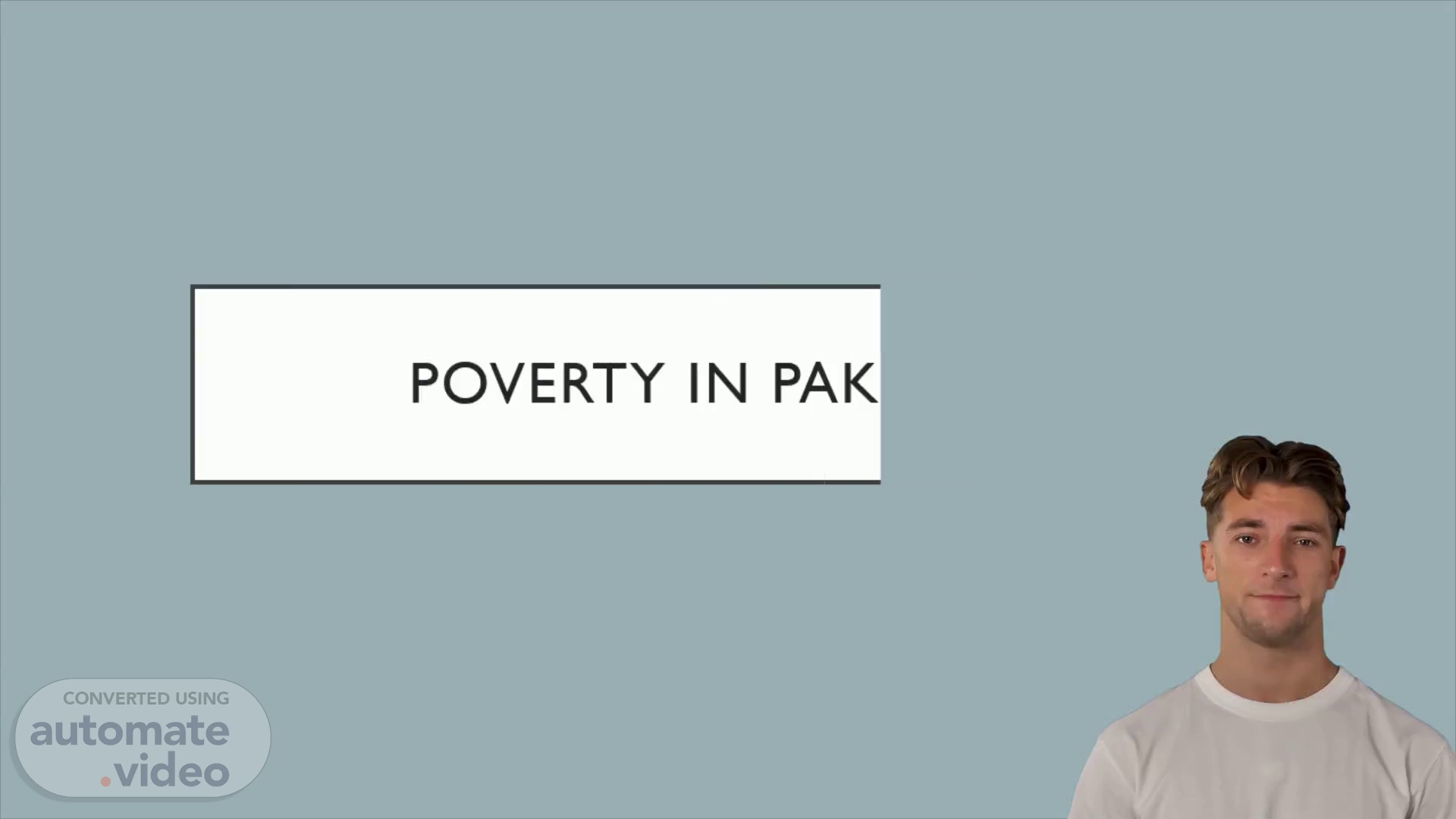Scene 1 (0s)
. POVERTY IN PAKISTAN.
Scene 2 (16s)
. OVERVIEW. Pakistan is the world's sixth most populous country, with 60% of its population under the age of thirty. Some of the most serious challenges confronting the country are political instability, gender disparities, rising inequalities, and the disastrous effects of climate change. One of the hot topics in Pakistan is poverty. According to a 2016 study, "about 39% of Pakistan's population lives below the poverty line" (World Bank). It translates to more than a third of the total population, or roughly 70 million out of 180 million people, living below the poverty line. Poverty was on the decline in the 1970s and 1980s, according to history. However, from 1990 to the present, poverty has increased. The poverty pump is a term used to describe this phenomenon..
Scene 3 (52s)
[Audio] Poverty in Pakistan remains a pressing issue. In 2018 it was estimated that 77.60 percent of the population lived in poverty, a 1.2 percent increase from 2015. Over a longer period, there has been a 4 percent decrease from 2013 and a cumulative drop of 6.5 percent down from 2010. These figures provide evidence of the magnitude of the problem and the dire need to tackle it..
Scene 4 (1m 21s)
[Audio] The gender bias in labor force is a consistent reality in many developing countries. Women are typically given fewer educational and job opportunities, resulting in a lower labor force participation rate and a lower chance of escaping poverty. Data analysis paints an interesting picture, as there are usually fewer poor female-headed households than male-headed households. This could be due to multiple factors, including the under-representation of female-headed households in certain cultures. Unfortunately, some female-headed households are even forced to appear as male-headed, due to societal pressures..
Scene 5 (2m 1s)
[Audio] Despite the known benefits of investing in education, many households in Pakistan lack access to it. This is evident in figure 1.5, which shows a correlation between household education level and poverty level. We can see a clear trend that as the education level of the household increases, the rate of poverty decreases. This indicates that educating households can help them to overcome multidimensional poverty and have better lives. Therefore, providing access to proper education to households in poverty can help them reduce their poverty situation substantially..
Scene 6 (2m 40s)
[Audio] The figure on this slide shows the poverty bands in Pakistan from 1998 to 2018. In 1998, 34.5% of individuals were classified as ultra-poor, living below 75% of the poverty line. This figure has declined to 5.5% in 2018. On the other hand, the non-poor have increased from 6.7% to 21.4%. It is clear that Pakistan has made good progress in poverty reduction, having the second lowest headcount poverty rate in South Asia..
Scene 7 (3m 18s)
[Audio] Poverty levels vary greatly across Pakistan's provinces. In 1998-99, Punjab had the lowest poverty rate of 61.8%, while the highest rate was recorded in Khyber Pakhtunkhwa at 71%. In 2018-19, the national poverty rate stood at 21.5%, with the lowest percentage in Punjab at 16.3% and the highest in Baluchistan at 40.7%. A significant trend in the overall poverty rate in Punjab has been a declining trend over the period under consideration. It is important to note that disparities exist between rural and urban areas in Pakistan. Urban poverty has declined at a much faster rate than rural poverty, likely due to increased access to educational opportunities, employment and social protection programs. In Sindh, the poverty rate has shown a mixed trend, with rural areas recording higher rates of poverty than urban areas. High levels of inequality, poor education and lack of job opportunities are the primary causes for poverty in Sindh..
Scene 8 (4m 29s)
[Audio] In Pakistan, the urban-rural divide is particularly stark. In rural areas poverty is significantly higher than in urban areas. This is likely due to unequal access to social services and limited opportunities for education, health, and employment. As a result, rural populations are being left behind and are often not being given the chance to reach their full potential..
Scene 9 (4m 55s)
[Audio] The poverty in Pakistan is a major issue, with economic, political and social factors at play. The government of Pakistan has implemented programs like the Benazir Income Support Program (BISP) and the Khushhali Microfinance Bank to alleviate poverty, though they have not been fully successful in achieving this goal. Moreover, the COVID-19 pandemic has further worsened the situation, leading to an increase in unemployment and a decrease in economic growth. It is essential that the government take steps to address this issue and work towards reducing inequality and increasing access to resources and services to improve the situation. Thank you for your attention..
